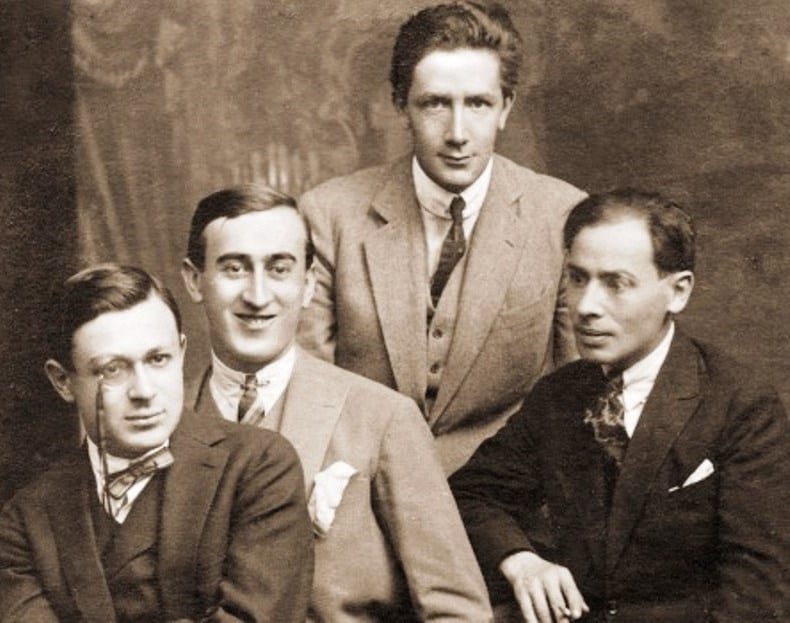While focusing on the new trends and events in the art of today, it is easy to forget the genius predecessors that shaped at the beginning of the 20th century, what modern art is today. Below we present 6 Romanian artists who significantly influenced the art movements such as Dada, Surrealism, and Constructivism decades ago.

The Chemarea circle in 1915. From left: Tzara, M. H. Maxy, Ion Vinea, and Jacques G. Costin
Tristan Tzara (1896 – 1963)
An avant-garde poet, writer, playwright, and film director. Best-known for being one of the co-founders of Dada, an anti-establishment, anti-art movement formed during the First World War in Zurich. There, in Café Versailles, and later in Paris, he engaged in disruptive, shocking performances meant to break the association between art and social standards, and which sometimes provoked the audience to the point of interrupting the show. In the early 1920s he started to dissociate himself with Dada (even enacting the movement’s symbolic funeral in 1922), and eventually transitioned to Surrealism. It was then that he began to take theatre more seriously, staging his plays, such as Handkerchief of Clouds exploring the connection between the subconscious, memory and perception. Adopting surrealism has also allowed him to experiment more than previously with his favourite technique of “cut-ups” which he would apply by cutting text or visual art into pieces and recomposing it into an unexpected, abstract final product (as described in his poem-manual To Make A Dadist Poem).

Marcel Janco on his atelier
Marcel Janco (1895 – 1984)
A Romanian and Israeli visual artist, architect and art theorist. Originally inspired by Art Nouveau, Expressionism and Futurism, in his twenties collaborated closely with Tzara, moving with him to Zurich where they would establish Dada and operate in Café Versailles. Having experimented with Dada for a few years, he gradually cut ties with the movement and moved towards Constructivism. He also educated himself on architecture throughout the 1920s and 1930s, and the introduction of modern architecture to central Bucharest can be attributed to him. As a Romanian Jew, he was persecuted by anti-Semites prior to and during the Second World War, which led him to move to Israel eventually. There, he imported the latest trends in Constructivism and founded Ein Hod, a utopian art colony functioning until this day. Most important pieces: Cabaret Voltaire (1916), Mask of Firdusi (1917-8), and Flower Geometry (1917).

Constantin Brâncuși, Photograph taken by Edward Steichen in 1922
Constantin Brâncuși (1876 – 1957)
A pioneer of modernism considered one of the most influential sculptors of the 20th century, “a patriarch of modern sculpture”. He studied art in Bucharest, Munich, and lastly – École des Beaux-Arts in Paris. Inspired by non-European cultures as well as Romanian folk traditions, he represented the mythical and traditional themes in sleek forms of clean geometrical lines. The resulting artworks were blends of the contemporary and the timeless, through which the artist hope to unveil some fundamental reality (thus he disagreed that his art was abstract, claiming it instead to be representational). Among his most famous pieces are: The Kiss (1907-8), Sleeping Muse I (1909-10), and Endless Column (1918).

Self portrait, Photo of Geta Brătescu
Geta Brătescu (1926 – 2018)
A contemporary visual artist of many media: illustration, drawing, collage, photography and even performance and film. As the Communist Party rose to power during her university years, she spent most of her career struggling to express herself amidst the restrictive censorship of the regime. Thus, her artwork has been somehow defined by this struggle, the 1978 collage of self-portraits Censored Self-Portrait being a perfect example. Among her other pieces that raise the question of self-identity is Towards White (1976) in which she seems to vanish into whiteness slowly. Her most famous film, The Studio (1978), meanwhile, is a dialogue between the body and space, a process by which one identifies with the place they occupy – such as an art studio.
Irina Codreanu (1896 – 1978)
A Paris-based sculptor who worked working mostly in stone. She first studied in Bucharest and then moved to Paris where she became a part of an Eastern European art community and a student of Émile-Antoine Bourdelle. Later, she worked in Constantin Brâncusi’s studio, which has influenced her style to a certain degree as evidenced by the stylized and polished finish of her busts, reminiscing Brâncusi’s simplified forms. Still, she is recognized for her own style which made her art pieces as if incomplete, with a degree of mystery in them. Her most representative sculptures include: Victory (1971, bronze), Grass (1973, pink granite), Draperie (1978, Carrara marble).
Victor Brauner, self-portrait, 1930
Victor Brauner (1903 – 1966)
A painter, illustrator, and sculptor. Having experimented with Dada and Expressionism, he eventually settled to express himself in Surrealism, at a point even collaborating with André Breton himself. His style was characterized by vivid colours, flattened perspectives (such as in The City I Dream, 1937), and complex iconography. He claimed his work to be chiefly autobiographical, and essential themes were usually coded in pieces through a diverse symbolic lexicon. Brauner believed to have predicted a loss of one eye in a fight, as showcased through the fixation on the image of a single eye in his work before the accident (see, e.g. Self-Portrait with Plucked Eye, 1931). This has gained him a reputation of a Seer among the Surrealists and introduced the recurring theme of a prophetic cyclops eye into his art. Body sketches like Anatomy of Desire (1935) – in which the portrayed figure is a grotesque hybrid of organic, artificial, and mechanical matter – are also typical of Brauner, and are believed to have been tools for channelling his own desires and anxieties.












